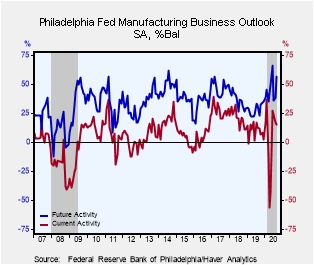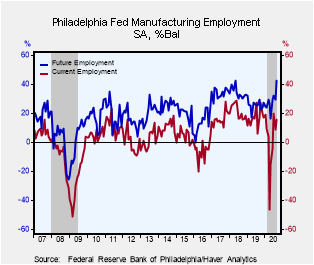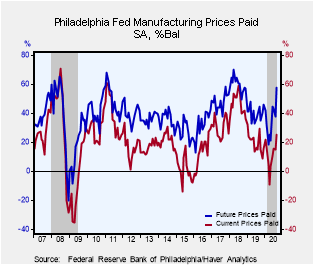 Global| Sep 17 2020
Global| Sep 17 2020Philadelphia Fed Manufacturing Index Slips but Underlying Details Stronger
by:Sandy Batten
|in:Economy in Brief
Summary
• Headline index slipped to 15.0 in September from 17.2. • But underlying details were noticeably stronger, particularly shipments. • Expectations rebound sharply. The Federal Reserve Bank of Philadelphia reported that its General [...]
• Headline index slipped to 15.0 in September from 17.2.
• But underlying details were noticeably stronger, particularly shipments.
• Expectations rebound sharply.
The Federal Reserve Bank of Philadelphia reported that its General Factory Sector Business Conditions Index fell in September to 15.0 from 17.2 in August. This was the fourth consecutive month in which the index has been in positive territory, indicating expansion, after having collapsed in March, April and May. The Action Economics Forecast Survey expected a slightly smaller decline to 15.5%. The percentage of firms reporting an improvement in business activity rose to 33% from 28% in August while the percentage reporting weaker conditions also rose to 18% from 11% in August. The survey results in this release reflect data received through September 14, 2020.
Note, however, that in contrast to the PMI the headline Philly Fed index is not calculated from the key underlying components but rather reflects the answer to a separate question. Consequently, Haver Analytics calculates an ISM-Adjusted General Business Conditions Index using the same underlying components that comprise the ISM index. This measure rose markedly to 57.3 in September, its highest reading since February, from 54.1 in August. This indicates that the respondents were more positive in answering the underlying detail questions than they were on the overall outlook.
In the details, the new orders index increased to 25.5 in September, its highest reading since February, from 19.0 in August. The shipments index was even stronger, jumping up to 36.6 in September, its highest reading since July 2004, from 9.4 in August. More than 45% of respondents reported an increase in shipments in September. Unfilled orders moved into positive territory for only the second time in the past seven months. Delivery times lengthened and the inventory correction continued.
On the labor front, the employment index rose to 15.7 in September from 9.0 in August, its third consecutive month in positive territory. The workweek index eased to 7.8 in September from 11.3 in August, showing a continued extension of the workweek though less widely spread than in August.
The index of prices paid rose to 25.1 in September from 15.3 in August, indicating that the reopening may be putting some upward pressure on input prices. The prices received index also rose in September, to 18.4 from 12.4 in August.
The hit from the pandemic and the associated lockdown has been enormous. Even with the rebound in activity than began in June, respondents, in answering a special question, estimated that the level of their Q3 production would be only 85% of what is was prior to the pandemic.
The Philadelphia Fed also surveys expectations for business activity in six months. The Future Activity Index soared to 56.6 in September from 38.8 in August. While this was still below its rebound to 66.3 in June, it reflected a return of optimism across the district.
The survey panel consists of 150 manufacturing companies in the third Federal Reserve District (which consists of southeastern Pennsylvania, southern New Jersey and Delaware). The diffusion indexes represent the percentage of respondents indicating an increase minus the percentage indicating a decrease in activity. The ISM-adjusted figure, calculated by Haver Analytics, is the average of five diffusion indexes: new orders, shipments, employment, delivery times and inventories with equal weights (20% each). Each ISM-adjusted index is the sum of the percent responding "higher" and one-half of the percent responding "no change."
The figures from the Philadelphia Federal Reserve dating back to 1968 can be found in Haver's SURVEYS database. The expectation from the Action Economics Forecast Survey is available in AS1REPNA.
| Philadelphia Fed - Manufacturing Business Outlook Survey (%, SA) | Sep | Aug | Jul | Sep'19 | 2019 | 2018 | 2017 |
|---|---|---|---|---|---|---|---|
| ISM-Adjusted Business Conditions | 57.3 | 54.1 | 53.6 | 58.5 | 55.5 | 57.7 | 57.2 |
| General Factory Sector Business Conditions | 15.0 | 17.2 | 24.1 | 12.2 | 9.9 | 20.9 | 27.3 |
| New Orders | 25.5 | 19.0 | 23.0 | 22.5 | 14.1 | 21.0 | 25.3 |
| Shipments | 36.6 | 9.4 | 15.3 | 24.2 | 16.9 | 22.8 | 26.7 |
| Unfilled Orders | 0.4 | -0.6 | 3.9 | 15.3 | 7.7 | 7.0 | 11.8 |
| Delivery Time | 12.2 | 7.3 | -6.4 | 11.3 | 9.4 | 9.5 | 10.6 |
| Inventories | -10.8 | -1.9 | -11.8 | 19.4 | 5.1 | 7.2 | 2.8 |
| Number of Employees | 15.7 | 9.0 | 20.1 | 17.5 | 16.9 | 21.5 | 16.1 |
| Average Workweek | 7.8 | 11.3 | 17.2 | 11.6 | 9.8 | 15.9 | 14.9 |
| Prices Paid | 25.1 | 15.3 | 15.7 | 29.7 | 19.7 | 46.1 | 30.4 |
| Expectations - General Business Conditions; Six Months Ahead | 56.6 | 38.8 | 36.0 | 23.1 | 28.4 | 36.8 | 47.1 |
Sandy Batten
AuthorMore in Author Profile »Sandy Batten has more than 30 years of experience analyzing industrial economies and financial markets and a wide range of experience across the financial services sector, government, and academia. Before joining Haver Analytics, Sandy was a Vice President and Senior Economist at Citibank; Senior Credit Market Analyst at CDC Investment Management, Managing Director at Bear Stearns, and Executive Director at JPMorgan. In 2008, Sandy was named the most accurate US forecaster by the National Association for Business Economics. He is a member of the New York Forecasters Club, NABE, and the American Economic Association. Prior to his time in the financial services sector, Sandy was a Research Officer at the Federal Reserve Bank of St. Louis, Senior Staff Economist on the President’s Council of Economic Advisors, Deputy Assistant Secretary for Economic Policy at the US Treasury, and Economist at the International Monetary Fund. Sandy has taught economics at St. Louis University, Denison University, and Muskingun College. He has published numerous peer-reviewed articles in a wide range of academic publications. He has a B.A. in economics from the University of Richmond and a M.A. and Ph.D. in economics from The Ohio State University.










